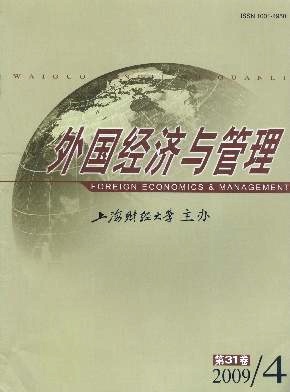国外可变薪酬激励效果及其影响因素研究述评
外国经济与管理 2009 年 第 31 卷第 04 期, 页码:59 - 65
摘要
参考文献
摘要
可变薪酬在企业的薪酬实践中得到了越来越广泛的运用。本文从可变薪酬的内涵和目标出发,对国外有关可变薪酬激励效果及其影响因素的研究成果进行了梳理和分析,指出了相关研究存在的若干问题,并在此基础上进一步指出了该领域未来的研究方向。
[1]Lazear,E P.Performance pay and productivity[J].American Economic Review,2000,90(5):1 346-1 361.
[2]Eriksson,T,and Villeval,MC.Performance-pay,sorting and social motivation[J].Journal of Economic Behavior&Organization,2008,68(2):412-421.
[3]Werner,S,and Ward,S G.Recent compensation research:An eclectic review[J].Human Resource Management Review,2004,14(2):201-227.
[4]Merri man,K K,and Deckop,J R.Loss aversion and variable pay:A motivational perspective[J].International Journal of HumanResource Management,2007,18(6):1 026-1 041.
[5]Cox,A.The outcomes of variable pay systems:Tales of multiple costs and unforeseen consequences[J].International Journal of Hu-man Resource Management,2005,16(8):1 475-1 497.
[6]Geddes,L A,and Heywood,J S.Gender and piece rates,commissions,and bonuses[J].Industrial Relations,2003,42(3):419-444.
[7]Deckop,J R,Mangel,R,and Cirka,C C.Getting more than you pay for:Organizational citizenship behavior and pay-for-perfor-mance plans[J].Academy of Management Journal,1999,42(4):420-428.
[8]Cadsby,C B,Song,F,and Tapon,F.Sorting andincentive effects of pay for performance:An experi mental investigation[J].Aca-demy of Management Journal,2007,50(2):387-405.
[9]Chang,C,Fuh,C D,and Hsu,Y H.ESO compensation:The roles of default risk,employee senti ment,and insider information[J].Journal of Corporate Finance,2008,14(5):630-641.
[10]Greenberg,J.Creating unfairness by mandating fair procedures:The hidden hazards of a pay-for-performance plan[J].Human Re-source Management Review,2003,13(1):41-57.
[11]Bozionelos,N,and Wang,Li.Aninvestigation on the attitudes of Chinese workers towards individually based performance-relatedreward systems[J].International Journal of Human Resource Management,2007,18(2):284-302.
[12]Kuhn,K M,and Yockey,M D.Variable pay as a risky choice:Determinants of the Relative attractiveness of incentive plans[J].Organizational Behavior and Human Decision Processes,2003,90(2):323-341.
[13]Schaubroeck,J,et al.An under-met and over-met expectations model of employee reactions to merit raises[J].Journal of AppliedPsychology,2008,93(2):424-434.
[14]Pokorny,K.Pay-but do not paytoo much:An experi mental study onthei mpact of incentives[J].Journal of Economic Behavior&Organization,2008,66(2):251-264.
[15]Hollensbe,E C,and Guthrie,J P.Group pay-for-performance plans:The role of spontaneous goal setting[J].Academy of Manage-ment Review,2000,25(4):864-872.
[16]Barber,A E,and Si mmering,MJ.Understanding pay plan acceptance:The role of distributivejustice theory[J].Human ResourceManagement Review,2002,12(1):25-42.
[17]Miceli,MP,and Heneman,R L.Contextual determinants of variable pay plan design:Aproposed researchframework[J].HumanResource Management Review,2000,10(3):289-305.
[18]Chang,E.Individual pay for performance and commit ment HR practices in South Korea[J].Journal of World Business,2006,41(4):368-381.
[19]Origo,F.Flexible pay,firmperformance and the role of unions:Newevidence fromItaly[J].Labour Economics,2009,16(1):64-78.
[20]Pekkarinen,T,and Riddell,C.Performance pay and earnings:Evidence frompersonnel records[J].Industrial and Labor RelationsReview,2008,61(3):297-319.
[2]Eriksson,T,and Villeval,MC.Performance-pay,sorting and social motivation[J].Journal of Economic Behavior&Organization,2008,68(2):412-421.
[3]Werner,S,and Ward,S G.Recent compensation research:An eclectic review[J].Human Resource Management Review,2004,14(2):201-227.
[4]Merri man,K K,and Deckop,J R.Loss aversion and variable pay:A motivational perspective[J].International Journal of HumanResource Management,2007,18(6):1 026-1 041.
[5]Cox,A.The outcomes of variable pay systems:Tales of multiple costs and unforeseen consequences[J].International Journal of Hu-man Resource Management,2005,16(8):1 475-1 497.
[6]Geddes,L A,and Heywood,J S.Gender and piece rates,commissions,and bonuses[J].Industrial Relations,2003,42(3):419-444.
[7]Deckop,J R,Mangel,R,and Cirka,C C.Getting more than you pay for:Organizational citizenship behavior and pay-for-perfor-mance plans[J].Academy of Management Journal,1999,42(4):420-428.
[8]Cadsby,C B,Song,F,and Tapon,F.Sorting andincentive effects of pay for performance:An experi mental investigation[J].Aca-demy of Management Journal,2007,50(2):387-405.
[9]Chang,C,Fuh,C D,and Hsu,Y H.ESO compensation:The roles of default risk,employee senti ment,and insider information[J].Journal of Corporate Finance,2008,14(5):630-641.
[10]Greenberg,J.Creating unfairness by mandating fair procedures:The hidden hazards of a pay-for-performance plan[J].Human Re-source Management Review,2003,13(1):41-57.
[11]Bozionelos,N,and Wang,Li.Aninvestigation on the attitudes of Chinese workers towards individually based performance-relatedreward systems[J].International Journal of Human Resource Management,2007,18(2):284-302.
[12]Kuhn,K M,and Yockey,M D.Variable pay as a risky choice:Determinants of the Relative attractiveness of incentive plans[J].Organizational Behavior and Human Decision Processes,2003,90(2):323-341.
[13]Schaubroeck,J,et al.An under-met and over-met expectations model of employee reactions to merit raises[J].Journal of AppliedPsychology,2008,93(2):424-434.
[14]Pokorny,K.Pay-but do not paytoo much:An experi mental study onthei mpact of incentives[J].Journal of Economic Behavior&Organization,2008,66(2):251-264.
[15]Hollensbe,E C,and Guthrie,J P.Group pay-for-performance plans:The role of spontaneous goal setting[J].Academy of Manage-ment Review,2000,25(4):864-872.
[16]Barber,A E,and Si mmering,MJ.Understanding pay plan acceptance:The role of distributivejustice theory[J].Human ResourceManagement Review,2002,12(1):25-42.
[17]Miceli,MP,and Heneman,R L.Contextual determinants of variable pay plan design:Aproposed researchframework[J].HumanResource Management Review,2000,10(3):289-305.
[18]Chang,E.Individual pay for performance and commit ment HR practices in South Korea[J].Journal of World Business,2006,41(4):368-381.
[19]Origo,F.Flexible pay,firmperformance and the role of unions:Newevidence fromItaly[J].Labour Economics,2009,16(1):64-78.
[20]Pekkarinen,T,and Riddell,C.Performance pay and earnings:Evidence frompersonnel records[J].Industrial and Labor RelationsReview,2008,61(3):297-319.
引用本文
赵海霞. 国外可变薪酬激励效果及其影响因素研究述评[J]. 外国经济与管理, 2009, 31(4): 59–65.
导出参考文献,格式为:





 6533
6533  399
399

